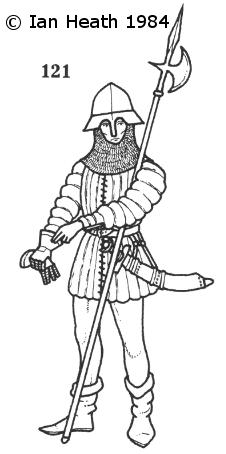
Amazon Audible Gift Memberships
BOHEMIAN INFANTRYMAN c.1400
An extract from Armies of the Middle Ages, Volume 2by Ian Heath



121. BOHEMIAN INFANTRYMAN c.1400
Based primarily on illustrations in the 'King Wenceslas Bible', this figure is representative of the troops who made up the Prague levy and other Bohemian civic militias. He wears a thickly-quilted gambeson, laced (or sometimes buttoned) down the front, and with underarm vents for ease of movement; others are shown entirely sleeveless. Note that the sleeves are buttoned tight at the wrists to allow gauntlets to fit over them (this detail being from a ms. of c. 1384). Other men would have been more heavily-armoured, Bohemian towns being supplied with some armours by the crown, which the municipal authorities then added to - Vysoke Myto, for example, had 300 pieces of armour, and Hradec Kralove 400, in 1362. Such armours were used both to equip mercenaries and poorer citizens (the citizenry being obliged to perform military service at their own expense whenever called upon, 2 quarters of the town at a time in Prague in 1371). Such militia infantry nevertheless usually only had the upper half of the body protected, regardless of the fact that a number of contemporary Bohemian sources show leg-harness being worn.
Though he carries no shield assorted mss. depict pavises, bucklers, oval and even large heater-shaped shields, the latter often with bosses, all in widespread use. His helmet dates to c.1380 but is of a type that could still be found in use even a century later. Indeed, the kettle-helmet remained the most popular type of helmet to be found amongst the infantry and less heavily-armed cavalry of Bohemia and elsewhere in Central and Eastern Europe until the end of this era. The type worn here, with the brim shaped into eyebrow ridges and with a long, outward-curving nasal, was characteristically Central European. The bascinet, as worn by 122, was the next most popular helmet-type, from the first half of the 14th century to the mid-15th, while the sallet only first occurs in Bohemian written sources in 1441, and in pictures a little earlier.
His side-arm is a falchion, called a tesák in Czech. Often scimitar-like in form by the end of the 14th century, it was adopted in neighbouring countries during and after the Hussite wars, becoming tasak in Polish and Düsack in German.